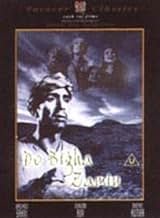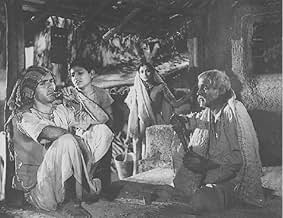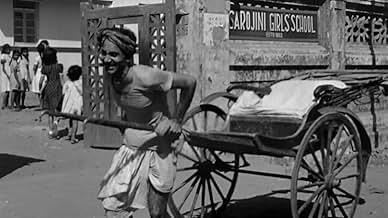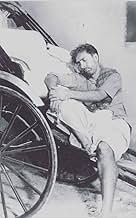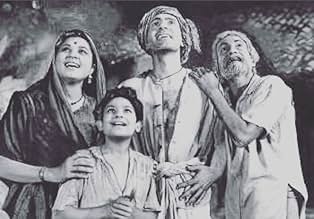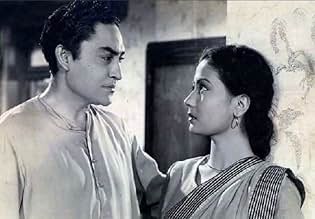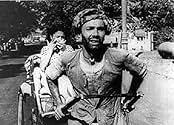IMDb रेटिंग
8.3/10
2.4 हज़ार
आपकी रेटिंग
अपना कर्ज चुकाने और अपनी जमीन बचाने के लिए पर्याप्त पैसा कमाने की उम्मीद में, एक गरीब किसान कलकत्ता में रिक्शा खींचने वाला बन जाता है और कई कठिनाइयों का सामना करता है.अपना कर्ज चुकाने और अपनी जमीन बचाने के लिए पर्याप्त पैसा कमाने की उम्मीद में, एक गरीब किसान कलकत्ता में रिक्शा खींचने वाला बन जाता है और कई कठिनाइयों का सामना करता है.अपना कर्ज चुकाने और अपनी जमीन बचाने के लिए पर्याप्त पैसा कमाने की उम्मीद में, एक गरीब किसान कलकत्ता में रिक्शा खींचने वाला बन जाता है और कई कठिनाइयों का सामना करता है.
- निर्देशक
- लेखक
- स्टार
- पुरस्कार
- 4 जीत और कुल 2 नामांकन
Ratan Kumar
- Kanhaiya Maheto
- (as Rattan Kumar)
Rajlakshmi Devi
- Nayabji
- (as Rajlakshmi)
Nasir Hussain
- Rickshaw puller
- (as Nazir Hussain)
Ramayan Tiwari
- Paro's molester
- (as Tiwari)
फ़ीचर्ड समीक्षाएं
Bimalda's Do Bigha Zameen is considered a gem in Indian movies. The movie has a slight socialist theme as did most movies of that time. If the younger generation of Chinese, Eastern Europeans and Russians wonder why they saw so many Indian movies this socialist theme, probably is the answer. Do Bigha Zameen won the first ever Filmfare award. The movie got a special mention at the Cannes film festival. The movie is about a farmer Shambhu (Balraj Sahni), who has been hit badly by a famine in Bengal. The real reason of his sorrow is that the Zamindaar (land owner) wants to acquire his land on the pretext that Shambhu had taken some loan from him. Shambhu has to pay back and hence he moves to the city.
The movie paints a very true picture of pre-independence (and early post independence) India. The society is agrarian yet the farmers are poor mainly because of the fact that they have very small land holdings and they are unlettered. The farmers were gullible while the land owner, money lender and the Brahmins were guile. A lot of people moved to the cities either in the anticipation of turning there fortunes or because they could not survive the atrocities of power holders. The movie has a theme that can be found in works of notable Indian authors Munshi Premchand or Sarat Chandra Chaterjee.
The most memorable scene from the movie is when Shambhu pushes himself to his limits pulling a hand pulled rikshaw. The rider on the riksha offers Shambhu more and more money to pull faster because he is chasing (probably) his girlfriend in another rikshaw. Note Shambhu's emotions, his smile in anticipation of getting more. Compare this with the rich class which is not worried the least about the lower class' plight. The lower class is no more then a machine that can be operated by putting in quarters. The rikshaw looses a wheel and Shambhu is injured.
This is the kind of movie that can not be spoilt even if I were to write the entire story down for you. This is art not suspense thriller. You must watch this movie not for the story but the direction and the acting abilities of Balraj Sahni and Nirupa Roy (Shambhu's wife).
In all these hardships Shambhu does not loose his righteousness which is the moral of the movie. Shambhu's son steals money to help his father only to be reproached by his father. Shambhu's morality is the only thing that remains his own till the end.
The movie is notable for Balraj Sahni's performance and since it is another of Bimal Roy's movies you can expect only the best. Personally I recommend any of the Bimal Roy movies. Like other movies by him, art and commercial form of cinema are merged to produce a movie that is still looked upon as a benchmark.
Finally the name of the movie means Two Bigha of Land. Bigha is a unit of measuring land. Bigha varies from state to state. In Bengal where the movie is based 3 Bigha is one Acre. So Shambhu owns only 2.7 sq. kilometres.
The movie paints a very true picture of pre-independence (and early post independence) India. The society is agrarian yet the farmers are poor mainly because of the fact that they have very small land holdings and they are unlettered. The farmers were gullible while the land owner, money lender and the Brahmins were guile. A lot of people moved to the cities either in the anticipation of turning there fortunes or because they could not survive the atrocities of power holders. The movie has a theme that can be found in works of notable Indian authors Munshi Premchand or Sarat Chandra Chaterjee.
The most memorable scene from the movie is when Shambhu pushes himself to his limits pulling a hand pulled rikshaw. The rider on the riksha offers Shambhu more and more money to pull faster because he is chasing (probably) his girlfriend in another rikshaw. Note Shambhu's emotions, his smile in anticipation of getting more. Compare this with the rich class which is not worried the least about the lower class' plight. The lower class is no more then a machine that can be operated by putting in quarters. The rikshaw looses a wheel and Shambhu is injured.
This is the kind of movie that can not be spoilt even if I were to write the entire story down for you. This is art not suspense thriller. You must watch this movie not for the story but the direction and the acting abilities of Balraj Sahni and Nirupa Roy (Shambhu's wife).
In all these hardships Shambhu does not loose his righteousness which is the moral of the movie. Shambhu's son steals money to help his father only to be reproached by his father. Shambhu's morality is the only thing that remains his own till the end.
The movie is notable for Balraj Sahni's performance and since it is another of Bimal Roy's movies you can expect only the best. Personally I recommend any of the Bimal Roy movies. Like other movies by him, art and commercial form of cinema are merged to produce a movie that is still looked upon as a benchmark.
Finally the name of the movie means Two Bigha of Land. Bigha is a unit of measuring land. Bigha varies from state to state. In Bengal where the movie is based 3 Bigha is one Acre. So Shambhu owns only 2.7 sq. kilometres.
Post world war II, cinema was deeply influenced by the Italian realist wave. Rosselini and Visconti's hard hitting social commentary and De Sica's day-to-day struggle changed film-making like never before (or since). This wave gave birth to directors like Kurosawa, Fellini and Ray. One of the Indian masterpieces of those days was Bimal Roy's Do Bigha Zamin, which can arguably be termed as the Indian answer to De Sica's The Bicycle Thief.
This film has it's heart in the right place. The indivisible nature of the family, all of whose members work towards the fulfillment of a single objective, which is the fabric of Indian society, is the beauty of the film. All of the members- Shambhu, his wife, his father and son, intend to alleviate his situation and try to contribute in every way possible. The film ends in a sad satirical note, which is the principle characteristic of neo-realistic cinema.
Story apart, the most beautiful aspect of the film is the spirit with which on upholding of one's dignity and self esteem in the most perturbing situations. Though, the protagonist, Shambhu could have executed his task easily many ways, he opts for the most ethical choice of all- hard work. It is quite evident that Do Bhiga Zamin has been influenced by (and has influenced) cinema spanning different geographical, linguistic, and social backgrounds, but it still has a firm foot in its culture.
This film has it's heart in the right place. The indivisible nature of the family, all of whose members work towards the fulfillment of a single objective, which is the fabric of Indian society, is the beauty of the film. All of the members- Shambhu, his wife, his father and son, intend to alleviate his situation and try to contribute in every way possible. The film ends in a sad satirical note, which is the principle characteristic of neo-realistic cinema.
Story apart, the most beautiful aspect of the film is the spirit with which on upholding of one's dignity and self esteem in the most perturbing situations. Though, the protagonist, Shambhu could have executed his task easily many ways, he opts for the most ethical choice of all- hard work. It is quite evident that Do Bhiga Zamin has been influenced by (and has influenced) cinema spanning different geographical, linguistic, and social backgrounds, but it still has a firm foot in its culture.
Bicycle Thieves is a very touching Italian movie. But this one is our own native version of that. With genuine plot and out-of-the-world cinematography, Do Bigha Zamin is Indian masterpiece.
The actors are terrific, totally portraying the characters given to them. Music, direction, screenplay & the execution is all marvelous. Even today, this works because it talks about poverty, life, emotions, relationships & virtues. Fantastic. Moreover, the intricacy with which details are kept in focus should be the USP of this film. 9.1/10.
BOTTOM LINE: Get that DVD right now. A must-watch.
Can be watched with a typical Indian family? YES
Profanity: No | Sex/Nudity: No | Violence: Very Mild | Gore: No | Alcohol/Smoking: No | Drugs: Mild (Hookah)
The actors are terrific, totally portraying the characters given to them. Music, direction, screenplay & the execution is all marvelous. Even today, this works because it talks about poverty, life, emotions, relationships & virtues. Fantastic. Moreover, the intricacy with which details are kept in focus should be the USP of this film. 9.1/10.
BOTTOM LINE: Get that DVD right now. A must-watch.
Can be watched with a typical Indian family? YES
Profanity: No | Sex/Nudity: No | Violence: Very Mild | Gore: No | Alcohol/Smoking: No | Drugs: Mild (Hookah)
Of course it is true that Do Bigha Zamin is strongly influenced by Vittorio de Sica's neorealist classic Bicycle Thieves (very improperly retitled Bicycle Thief in the English version). But De Sica's film has influenced virtually every realist film (and many non-realist films) ever since the day it first appeared. It is a crucial reference in world cinema and will probably always remain one.
It was of course particularly influential on all the Indian neo-realists of the fifties, including the greatest of them all - Satyajit Ray. Roy, like Ray a Bengali, would have imbibed that influence before ever he abandoned New Theatres in Calcutta to come to Bombay. He is not an especially innovative director. Devdas (1955) for instance is essentially a Hindi remake of a thirties classic of Bengali cinema; other Roy films show an eclectic range of influences. So it is not surprising to find him in Do Bigha Zamin attempting to adapt the style (and to some extent) the structure of Bicycle Thieves to an Indian context.
Once one has admitted that, however, it should not I think be seen as some sort of shameful plagiarism and one can go on to appreciate some of the real plusses of Roy's film. It is true that it is less restrained than the Italian model; Roy piles on the agony in no uncertain terms and tends to oversentimentalize. Note however that he resists any facile optimism...
The adaptation to a rural Indian context alters the politics of the film, concentrating on the issue (a burning issue to this day in rural India) of the cycle of debt and exploitation to which small peasant farmers in India are subjected (a theme that Mehboob Kahn had already explored in his film Aurat and would do again most famously in Mother India in 1957). This is a less subtle theme perhaps than that of De Sica (where in an urban context it is the poor who steal from the poor and prolong the cycle of misery) but it is nonetheless an important one and Roy (and Balraj Sahni who is excellent) paints a convincing picture of village-life and rural values.
Roy very deliberately counterbalances the picture of misery (rural and urban) with examples of solidarity, of the poor helping the poor, whether on the level of the adults or of the street-boys. And perhaps the most touching and most natural part of Roy's film - and something that owes nothing to De Sica - is his portrayal of the street-kids of Calcutta (which very interestingly prefigures Mira Nair's much later Salaam Bombay). Instead of being isolated companions as in the De Sica film, the father and son in Roy's film experience two rather different aspects of urban life and this layering of the story is perhaps Roy's most significant achievement.
Can one put paid once and for all, finally, to this idea that a realistic film or a film showing social awareness is uncharacteristic of Indian cinema (based on an essentially modern image of "Bollywood")? The golden age of Indian cinema (say 1949 to 1964) abounds in realistic films and films which, while not necessarily realistic in a strict sense of the term, show a good deal of social awareness. It is the period that includes the most memorable films of Satyajit Ray, Rithwik Gathak and Tapan Sinha, the films of Guru Dutt, the early films of Raj Kapoor, those of Bimal Roy, Mehboob Kahn's Mother India but also amongst relatively minor films, Arora's Boot Polish and B R Chopra's Naya Daur. To say nothing of great films in a non-realistic genre such as Mughal-e-Azam (1960) and Pakeezah (largely filmed during the period although not completed until 1972). By comparison with any contemporary cinema anywhere in the world including certainly American cinema, including even that of Japan (also experiencing something of a golden age at that time), it is a very impressive record.
Roy may not be amongst the first rank of cinematic geniuses - I would not put him in the same class as Ray or Gathak or for that matter as Guru Dutt, in my view the finest of the Hindi film directors of the period. He was a populariser (quite determinedly so) and constituted as such an important bridge between the more 'arty' Bengali and more 'popular' Hindi film industries of the time. His contribution remains an important and enduring one to an Indian cinema (and a popular Indian cinema) of real quality that has nothing to do with "Bollywood"...
It was of course particularly influential on all the Indian neo-realists of the fifties, including the greatest of them all - Satyajit Ray. Roy, like Ray a Bengali, would have imbibed that influence before ever he abandoned New Theatres in Calcutta to come to Bombay. He is not an especially innovative director. Devdas (1955) for instance is essentially a Hindi remake of a thirties classic of Bengali cinema; other Roy films show an eclectic range of influences. So it is not surprising to find him in Do Bigha Zamin attempting to adapt the style (and to some extent) the structure of Bicycle Thieves to an Indian context.
Once one has admitted that, however, it should not I think be seen as some sort of shameful plagiarism and one can go on to appreciate some of the real plusses of Roy's film. It is true that it is less restrained than the Italian model; Roy piles on the agony in no uncertain terms and tends to oversentimentalize. Note however that he resists any facile optimism...
The adaptation to a rural Indian context alters the politics of the film, concentrating on the issue (a burning issue to this day in rural India) of the cycle of debt and exploitation to which small peasant farmers in India are subjected (a theme that Mehboob Kahn had already explored in his film Aurat and would do again most famously in Mother India in 1957). This is a less subtle theme perhaps than that of De Sica (where in an urban context it is the poor who steal from the poor and prolong the cycle of misery) but it is nonetheless an important one and Roy (and Balraj Sahni who is excellent) paints a convincing picture of village-life and rural values.
Roy very deliberately counterbalances the picture of misery (rural and urban) with examples of solidarity, of the poor helping the poor, whether on the level of the adults or of the street-boys. And perhaps the most touching and most natural part of Roy's film - and something that owes nothing to De Sica - is his portrayal of the street-kids of Calcutta (which very interestingly prefigures Mira Nair's much later Salaam Bombay). Instead of being isolated companions as in the De Sica film, the father and son in Roy's film experience two rather different aspects of urban life and this layering of the story is perhaps Roy's most significant achievement.
Can one put paid once and for all, finally, to this idea that a realistic film or a film showing social awareness is uncharacteristic of Indian cinema (based on an essentially modern image of "Bollywood")? The golden age of Indian cinema (say 1949 to 1964) abounds in realistic films and films which, while not necessarily realistic in a strict sense of the term, show a good deal of social awareness. It is the period that includes the most memorable films of Satyajit Ray, Rithwik Gathak and Tapan Sinha, the films of Guru Dutt, the early films of Raj Kapoor, those of Bimal Roy, Mehboob Kahn's Mother India but also amongst relatively minor films, Arora's Boot Polish and B R Chopra's Naya Daur. To say nothing of great films in a non-realistic genre such as Mughal-e-Azam (1960) and Pakeezah (largely filmed during the period although not completed until 1972). By comparison with any contemporary cinema anywhere in the world including certainly American cinema, including even that of Japan (also experiencing something of a golden age at that time), it is a very impressive record.
Roy may not be amongst the first rank of cinematic geniuses - I would not put him in the same class as Ray or Gathak or for that matter as Guru Dutt, in my view the finest of the Hindi film directors of the period. He was a populariser (quite determinedly so) and constituted as such an important bridge between the more 'arty' Bengali and more 'popular' Hindi film industries of the time. His contribution remains an important and enduring one to an Indian cinema (and a popular Indian cinema) of real quality that has nothing to do with "Bollywood"...
After watching the Satyajit Ray films, The Apu Trilogy (1955-1959) and Devi (1960), I decided to check out some of the realistic films directed by other Bengali filmmakers during that same era. One of the films I found was Do Bigha Zamin, which won the International Prize at the 1954 Cannes Film Festival.
Although it's a Hindi-language film, and therefore technically a 'Bollywood' movie, the film's director Bimal Roy is from Bengal, thus the film has more in common with Bengali art cinema than it does with mainstream Bollywood as a result. The film does have a few musical numbers, like a lot of other Hollywood and Bollywood movies of that era, but what sets Do Bigha Zamin apart is its greater sense of realism. Beyond the few musical numbers, the film itself doesn't have much melodrama to it and there isn't much of a background score either, which is a good thing to me as a sappy or sentimental score isn't necessary for a film like this.
Do Bigha Zamin is very much a character-driven drama and the actors did a great job in portraying their respective characters. The performances which stand out most are Balraj Sahni as the farmer Shambu, the protagonist of the story, and the child actor Rattan Kumar as his son Kanhaiya. Nirupa Roy also gave a very good performance as Shambu's wife Paro.
As for Bimal Roy's direction, the film has one of the best depictions of poverty I've ever seen, covering both rural poverty in a Bengali village and urban poverty in Calcutta (now Kolkata), including the plight of street kids living in the city's slums. The film's ending was also powerful and it was overall a very moving film.
8/10
Although it's a Hindi-language film, and therefore technically a 'Bollywood' movie, the film's director Bimal Roy is from Bengal, thus the film has more in common with Bengali art cinema than it does with mainstream Bollywood as a result. The film does have a few musical numbers, like a lot of other Hollywood and Bollywood movies of that era, but what sets Do Bigha Zamin apart is its greater sense of realism. Beyond the few musical numbers, the film itself doesn't have much melodrama to it and there isn't much of a background score either, which is a good thing to me as a sappy or sentimental score isn't necessary for a film like this.
Do Bigha Zamin is very much a character-driven drama and the actors did a great job in portraying their respective characters. The performances which stand out most are Balraj Sahni as the farmer Shambu, the protagonist of the story, and the child actor Rattan Kumar as his son Kanhaiya. Nirupa Roy also gave a very good performance as Shambu's wife Paro.
As for Bimal Roy's direction, the film has one of the best depictions of poverty I've ever seen, covering both rural poverty in a Bengali village and urban poverty in Calcutta (now Kolkata), including the plight of street kids living in the city's slums. The film's ending was also powerful and it was overall a very moving film.
8/10
क्या आपको पता है
- ट्रिवियाWhen the shoeshine boys discuss seeing Nargis in Awaara (1951), one of them alludes to a shirt worn by a bystander. The shirt is decorated with a recurring pattern showing the famous scene from Awaara (1951) in which Raj Kapoor comes upon Nargis as she is changing clothes, partially hidden by a screen, after swimming. That scene occupies a place in Hindi cinema comparable to that of Deborah Kerr and Burt Lancaster on the beach in From Here to Eternity (1953).
- कनेक्शनFeatured in Century of Cinema: And the Show Goes On: Indian Chapter (1996)
- साउंडट्रैकhariyaala saawan dhol bajaata aaya
Sung by Lata Mangeshkar, Manna Dey
टॉप पसंद
रेटिंग देने के लिए साइन-इन करें और वैयक्तिकृत सुझावों के लिए वॉचलिस्ट करें
2025 Venice Film Festival Guide
2025 Venice Film Festival Guide
See the full lineup for the 2025 Venice Film Festival, taking place Aug. 27 – Sept. 9, 2025.
- How long is Do Bigha Zamin?Alexa द्वारा संचालित
विवरण
- चलने की अवधि2 घंटे 11 मिनट
- रंग
- पक्ष अनुपात
- 1.37 : 1
इस पेज में योगदान दें
किसी बदलाव का सुझाव दें या अनुपलब्ध कॉन्टेंट जोड़ें



